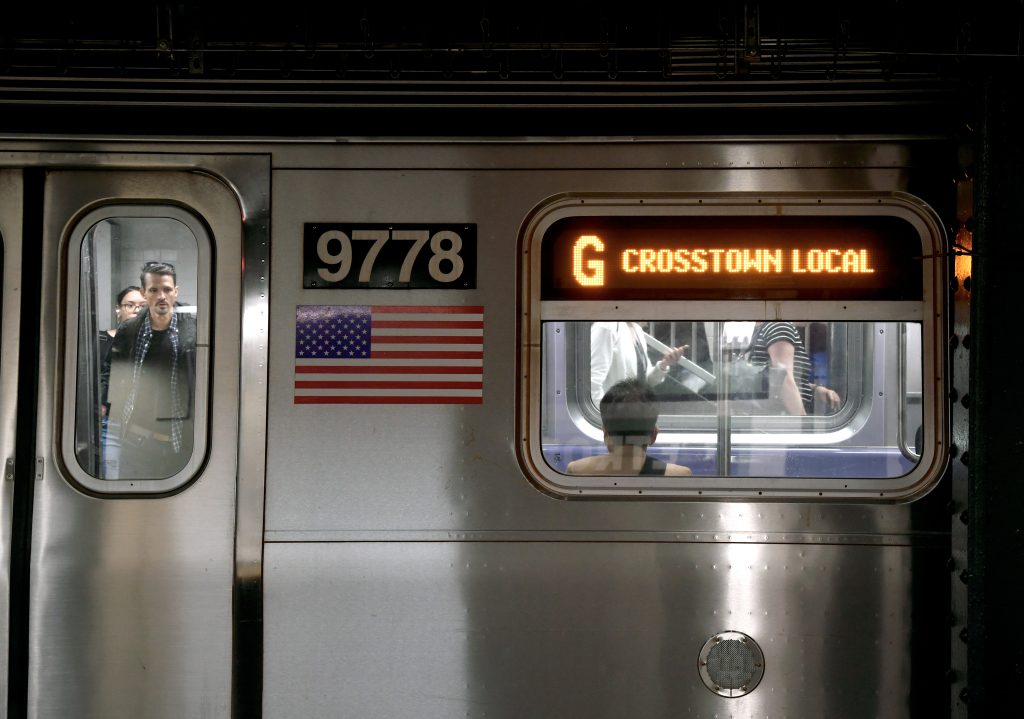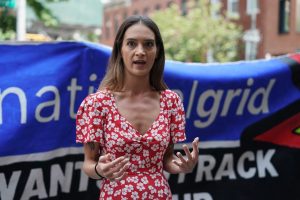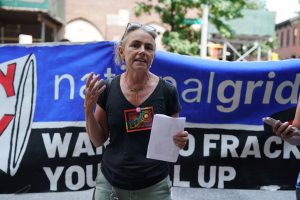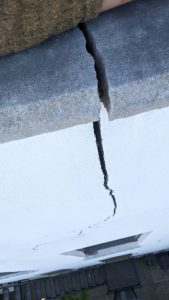Read, Play, Love; Brooklyn Children’s Book Author Randall de Sève on Process and Purpose and Her Latest Release

Photo Credit: Alexander Bernhardt Bloom
By Alexander Bernhardt Bloom | alex@queensledger.com
Students in our city’s five boroughs returned to school last week, a moment which, — as anyone who has been a student, or the parent of a student, or the teacher of students, will know — summons fear, anxiety, courage, and exhilaration in them all at once.
The materials mailed during the summertime to the caregivers of many of those students offered suggestions for best preparing their youngsters for the return. One of those suggestions was reading.
Children see themselves in the stories they read and have read to them; they identify with stories’ characters and wade through the conflicts they might encounter only to rejoice with them at their resolution. Story books, especially those concerning schools and lessons and learning, can be a terrific way for a young person to simulate the experiences they will begin to face for real when the first day arrives in September, goes the suggestion, and so off went many parents of students-to-be in search of just those for use with their youngsters during the waning days of the summer recess.
They’d encounter an excellent one in Sometimes We Fall, the latest release from children’s book author Randall de Sève, which arrived on the shelves of book shops in her home borough of Brooklyn, in the rest of the city, and elsewhere last month – just in time.
That the story concerns a family of bears and that its setting is a plum tree is no matter. Most children’s books can be understood as parables in some way or another, their apparent simplicity a thin disguise for the powerful, universal themes they usually make their focus. Clever, clipped language and cute characters and eye-catching illustrations are simply devices that the children’s book author reaches for to help deliver a message about those themes, and if you think about it, most every children’s book has a message to deliver about something.
* * *
Sometimes We Fall opens with an image of a great, brown bear nestled high in the branches of a tree whose limbs are decorated with ripe fruit. Another bear, much smaller, sits stock still below, half-hidden in the tall grass, looking up at her in awe.
“It’s a problem when…,” the text begins. Told using the little bear’s voice both spoken and in narration, the story goes on to pose hypotheticals considering all of the things that might go wrong along the way, from the little bear’s spot in the grass to their consumption of the rich, ripe plums in the branches up high. “What if?,” asks the little bear.
The bigger bear, the cub’s mother, we learn, answers each of these queries from above: “Sometimes,” she replies repeatedly, “(said misfortune occurs).” Adding, “It’s okay.”
The bear cub continues with concerned questions.
The tree’s solemn branches play witness. The ripe summer fruit continues to beckon.
* * *
That Sometimes We Fall is thematically-suited for the apprehensive child approaching the new school year did make its arrival feel just in time this summer, but that wasn’t exactly a marketing scheme. In fact, the process by which a picture book is produced, unlike the narratives they usually contain, is frequently long and nonlinear. So it was, in the case of Sometimes We Fall, explained de Sève, on a late-summer afternoon at her home in Park Slope.
Her most recent release, the author’s eighth picture book for children, was written over the course of a year and produced and prepared for publication over the course of several. It started with a short and fleeting moment.

Photo Credit: Alexander Bernhardt Bloom
On a visit in Connecticut, she watched through the window of a house in the country while a mother bear scaled a towering tree beside it, finally reaching a height as tall as the top stories of the brownstones that populate de Sève’s neighborhood in Brooklyn.
“And then there were these two cubs, and they were tiny at the bottom,” she recalls, “and they were watching and they kept trying, and they kept trying and falling and trying and falling.” She looked on in awe and sympathy and identification. There was something big in this little moment and de Sève would carry it with her for a time afterward.
“I couldn’t stop thinking about it,” she remembers, and finally realized she had the seed for a new story. “I lived with those bears, the real bears, for a long time before I realized what I wanted to say with them. I didn’t start writing until I knew. ”
It was a similar generative process for de Sève as with previous projects, a period of rumination and selection and development most readers are surprised to learn about. “The golden rule is 500 words or less,” she confided, although some children’s books authors bend, break or ignore it. To begin with at least, there are many more than that. “In my first draft I do write a lot of art notes, particularly when there are pauses in the telling but the story goes on with showing.”
As the narrative shape of the story begins to take form, so too do the visuals that will support or even drive it: “I’ll sometimes have a line that will say, ‘no text, art:’ and then a description of what I imagine.”

Image Courtesy of Random House Studio
In the end de Sève takes most of these notes out, an act of confidence comparable to stripping the scaffolding off of a nearly constructed building, but also a way of expressing trust in the collaborators who will see the book through its next steps of development. Leave room for the artist to do their job too, an editor told de Sève early in her career.
In most cases she’ll never actually sit down with those collaborators. It is a curious question of chicken or the egg for most consumers of children’s picture books, who imagine that when a story’s illustrations form such an important part of its telling they must have been proposed first, or at least at the same time the story’s text as the thing was being written. Not so. Always first is the story, explained de Sève, and most times the choices about art and design and story-mapping happen afterward, far from the person who first wrote it.
For Sometimes We Fall de Sève communicated with illustrator Kate Gardiner by email, and indirectly, sending notes through the editor as a third party while the artist sketched through the story’s pages. De Sève was finally very pleased with her work. Gardiner’s clean and serene landscapes, her obvious, touchable objects as props, and the simple lines used to create deeply expressive characters, all seem uniquely-suited to de Sève’s story, but really the artist’s work represents a sort of intuitive connection with the story’s text and themes.

Image Courtesy of Random House Studio
Which brings us back to the story’s writing. “When a child has a favorite book,” de Sève pointed out, and as every parent knows, “you’re going to have to read it a hundred times, so it has to keep giving.” It’s a delicate balancing act, for the story must come through clearly for the child but also be related in a voice imaginative enough to hold their attention and that of the grown-up reading it to them. Not every children’s book does this effectively, and the young and old consumers of these stories recognize the difference pretty quickly.
They are the children and their caregivers both who reach for certain books over and over again while others languish on the shelf, and you need only listen in: “When a parent or caregiver appreciates the voice or the characters or the writing, that comes through in the reading too,” remarked de Sève, “They read that story with a greater degree of care.”
Equally important is the content of the narrative, and for de Sève, generally, less is more. “Children’s media can be very loud – and I don’t mean audible level.” She appreciates books with a linear narrative, clear settings, sparse use of things like text balloons and the absence of what she calls “visual screaming.”
Indeed, Sometimes We Fall could be described well the way de Sève describes her favorite children’s books: “Stories where not much happens, that are calm and beautiful and honor the bigness of a tiny moment. Because that is life for a child – a string of tiny moments.”

Photo Credit: Alexander Bernhardt Bloom
It is the author’s intention to capture those tiny moments in her stories, and create a chance for children and their caregivers to enter them together. It starts with the child’s sensibility. “When you’re walking around in the world with a child, they’ll bend down and pick up a stone, or find a little shell on the beach, or see a little flower, or hear a siren. These things that we take for granted as adults – it’s all new for children, and you realize how much magic is in our world.” Reading a story book gives these parties a chance to examine that magic together.
How true.
My three year-old furrows his eyebrows, reading Sometimes We Fall, with the little bear’s first attempts to climb. He cries “oh no!,” when the cub slips or a branch breaks. He caught the repetitive pattern and soon began to join in chorus for the mother’s responses, “it’s okay,” and he laughs with glee at the cub’s satisfaction with its first fruit. When the little bear is finally reunited with its mother – forgive the spoiler – my son turns away from the story book’s pages, nuzzling into my side as does the bear in the tree in the illustrations. “I want a plum,” he usually concludes.
Children don’t read stories, they live them.
* * *
Back in the garden of Randall de Sève’s home in Brooklyn, she paused for a moment from what she’d been saying as a helicopter flew overhead. In an adjacent backyard motorized garden-grooming tools made their terrific racket, and traffic and faint music and the sounds that come off of Brooklyn avenues met our ears from afar.
Our children live in a noisy world, and story books can be a way to quiet it and give them a supportive nudge as they muddle through the complicated parts of growing up and becoming themselves.
“What a privilege it is – to be able to talk to young children and their caregivers through this work that I do. The big emotions that they grapple with growing, and honestly, that we all grapple with throughout our lives, can be explored through these stories.”
For returning New York City school children – and their caregivers, and their teachers – de Sève had a clear message to offer in Sometimes We Fall. “A life well-lived requires risk. Sometimes we do fall, and hopefully we get back up and try again, because it’s usually worth it.” She laughed softly, reaching skyward, “Get that plum.”

Photo Credit: Alexander Bernhardt Bloom





































































